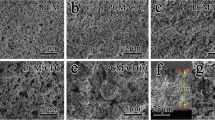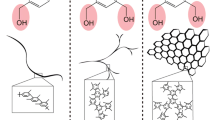Abstract
This paper focuses on the superiority of organic-inorganic hybrid ion-gel electrolytes for lithium-ion batteries (LiBs) over commercial electrolytes, such as 1 M LiPF6 in 1:1 ethylene carbonate (EC): dimethyl carbonate (DMC) {1 M LiPF6-EC: DMC}, in terms of their flame susceptibility. These ion-gel electrolytes possess ionic liquid monomers, which are confined within the borosilicate or silicate matrices that are ideal for nonflammability. Naked flame tests confirm that the organic-inorganic hybrid electrolytes are less susceptible to flames, and these electrolytes do not suffer from a major loss in terms of weight. In addition, the hybrids are self-extinguishable. Therefore, these hybrids are only oxidized when subjected to a flame unlike other commercial electrolytes used in lithium-ion batteries. Supplementary analyses using differential scanning calorimetric studies reveal that the hybrids are glassy until the temperature reaches more than 100°C. The current results are consistent with previously published data on the organic-inorganic hybrids.
Similar content being viewed by others
References
Tarascon JM, Armand M. Issues and challenges facing rechargeable lithium batteries. Nature, 2001, 414(6861): 359–367
Zaghib K, Charest P, Guerfi A, Shim J, Perrier M, Striebel K. Safe Li-ion polymer batteries for HEV applications. Journal of Power Sources, 2004, 134(1): 124–129
Armand M, Tarascon J M. Building better batteries. Nature, 2008, 451(7179): 652–657
Goodenough J B, Park K S. The Li-ion rechargeable battery: a perspective. Journal of the American Chemical Society, 2013, 135 (4): 1167–1176
Li N, Song H, Cui H, Wang C. Sn@graphene grown on vertically aligned graphene for high-capacity, high-rate, and long-life lithium storage. Nano Energy, 2014, 3: 102–112
Li N, Jin S, Liao Q, Cui H, Wang C X. Encapsulated within graphene shell silicon nanoparticles anchored on vertically aligned graphene trees as lithium ion battery anodes. Nano Energy, 2014, 5: 105–115
Li N, Song H, Cui H, Yang G, Wang C. Self-assembled growth of Sn@ CNTs on vertically aligned graphene for binder-free high Listorage and excellent stability. Journal of Materials Chemistry A, 2014, 2(8): 2526–2537
Williard N, He W, Hendricks C, Pecht M. Lessons learned from the 787Dreamliner issue on the lithium-ion battery reliability. Energies, 2013, 6(9): 4682–4695
Wang Q, Ping P, Zhao X, Chu G, Sun J, Chen C. Thermal runaway caused by fire and explosion of lithium-ion battery. Journal of Power Sources, 2012, 208: 210–224
Sloop S E, Pugh J K, Wang S, Kerr J B, Kinoshita K. Chemical reactivity of PF5 and LiPF6 in ethylene carbonate/dimethyl carbonate solutions. Electrochemical and Solid-State Letters, 2001, 4(4): A42–A44
Spotnitz R, Franklin J. Abuse behavior of high power, lithium-ion cells. Journal of Power Sources, 2003, 113(1): 81–100
Spotnitz R M, Weaver J, Yeduvaka G, Doughty D H, Roth E P. Simulation of abuse tolerance of lithium-ion battery packs. Journal of Power Sources, 2007, 163(2): 1080–1086
Kim G H, Pesaran A, Spotnitz R. A three-dimensional thermal abuse model for lithium-ion cells. Journal of Power Sources, 2007, 170(2): 476–489
Harris S J, Timmons A, Pitz W J. A combustion chemistry analysis of carbonate solvents used in Li-ion batteries. Journal of Power Sources, 2009, 193(2): 855–858
Lisbona D, Snee T. A review of hazards associated with primary lithium and lithium-ion batteries. Process Safety and Environmental Protection, 2011, 89(6): 434–442
Ota H, Kominato A, Chun W J, Yasukawa E, Kasuya S. Effect of cyclic phosphate additive in non-flammable electrolyte. Journal of Power Sources, 2003, 119–121: 393–398
Wang X, Yamada C, Naito H, Segami G, Kibe K. High concentration trimethyl phosphate-based non-flammable electrolytes with improved charge-discharge performance of a graphite anode for lithium-ion cells. Journal of the Electrochemical Society, 2006, 153(1): A135–A139
Wen J, Yu Y, Chen C. A review on lithium-ion batteries safety issues: existing problems and possible solutions. Materials Express, 2012, 2(3): 197–212
Martinelli A. Effects of a protic ionic liquid on the reaction pathway during non-aqueous sol-gel synthesis of silica: a Raman spectroscopic investigation. International Journal of Molecular Sciences, 2014, 15(4): 6488–6503
Matsumi N, Toyota Y, Joshi P, Puneet P, Vedarajan R, Takekawa T. Boric ester-type molten salt via dehydrocoupling reaction. International Journal of Molecular Sciences, 2014, 15(11): 21080–21089
Smaran K S, Vedarajan R, Matsumi N. Design of organic-inorganic hybrid ion-gel electrolytes composed of borosilicate and allylimidazolium type ionic liquids. International Journal of Hydrogen Energy, 2014, 39(6): 2936–2942
Hess S, Wohlfahrt-Mehrens M, Wachtler M. Flammability of Li-ion battery electrolytes: flash point and self-extinguishing time measurements. Journal of the Electrochemical Society, 2015, 162 (2): A3084–A3097
Mizumo T, Marwanta E, Matsumi N, Ohno H. Allylimidazolium halides as novel room temperature ionic liquids. Chemistry Letters, 2004, 33(10): 1360–1361
Smaran K S, Joshi P, Vedarajan R, Matsumi N. Optimisation of potential boundaries with dynamic electrochemical impedance spectroscopy for an anodic half-cell based on organic–inorganic hybrid electrolytes. ChemElectroChem, 2015, 2(12): 1913–1916
Acknowledgements
This work was supported by the MEXT scholarship of the Japanese Government. The authors wish to thank Prof. Vito Di Noto of the University of Padova, Italy for helping with the DSC measurements.
Author information
Authors and Affiliations
Corresponding author
Rights and permissions
About this article
Cite this article
Smaran, K.S., Badam, R., Vedarajan, R. et al. Flame-retardant properties of in situ sol-gel synthesized inorganic borosilicate/silicate polymer scaffold matrix comprising ionic liquid. Front. Energy 13, 163–171 (2019). https://doi.org/10.1007/s11708-018-0554-2
Received:
Accepted:
Published:
Issue Date:
DOI: https://doi.org/10.1007/s11708-018-0554-2




